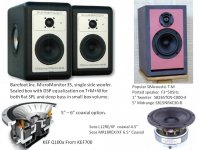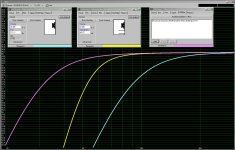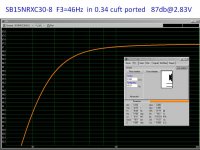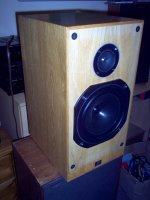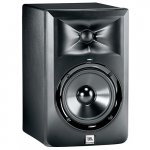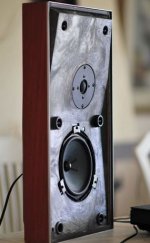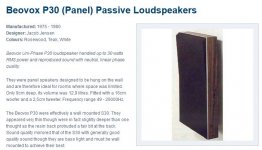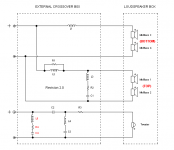Hi all
sorry if my post is very rough and confusing.
I'd like to build an HiFi system. I have clear ideas regarding the amplifier. I have no knowledge instead about speakers.
I have a room of about 38m^3 (l x w x h = 4,2 x 2,95 x 3).
I would like to place the speakers at about 2.2m from floor with horizontal orientation (on a shelf) along the largest side.
I would like that the speakers are as small as possible.
The amplifiare will be capable of delivering 68W of continuous average power to a 4Ω load.
Questions:
1. Do you suggest me 2 way or 3 way?
2. How can I select components (tweeter, midrange, etc)? What parameters should I consider? What formulas? For example: how can I calculate output power for each component? Impendence?
3. Can you give me some example for each component? Brand, model etc...
4. is it feasible to place the speakers so high? They will be directed down?
5. Can you suggest some link to similar projects?
Thanks
Regards
Giuseppe
sorry if my post is very rough and confusing.
I'd like to build an HiFi system. I have clear ideas regarding the amplifier. I have no knowledge instead about speakers.
I have a room of about 38m^3 (l x w x h = 4,2 x 2,95 x 3).
I would like to place the speakers at about 2.2m from floor with horizontal orientation (on a shelf) along the largest side.
I would like that the speakers are as small as possible.
The amplifiare will be capable of delivering 68W of continuous average power to a 4Ω load.
Questions:
1. Do you suggest me 2 way or 3 way?
2. How can I select components (tweeter, midrange, etc)? What parameters should I consider? What formulas? For example: how can I calculate output power for each component? Impendence?
3. Can you give me some example for each component? Brand, model etc...
4. is it feasible to place the speakers so high? They will be directed down?
5. Can you suggest some link to similar projects?
Thanks
Regards
Giuseppe
Hello Giuseppe! Your message is clear enough, however you are asking questions that are still very general and broad. Speakers, especially to build your own, must be the DIY creative area of greatest freedom. Here are some questions to help us help you:
1. What types of music do you like to listen to? Obviously your amplifier limits how much power, but you can get very loud in a small room even with a small speaker and 35 watts.
2. How much money are you willing to spend? You do not need to spend huge amounts to get good sound. I am just an amateur, but I could buy (at USA prices, cheaper than Europe certainly -- even for European stuff !!! 😀 ) drivers for two speakers $100 or less. More $ gets you more quality but diminishing returns at some point.
3. What, if any, materials (wood?) and tools (work shop? Space Age CNC wood works when the boss is away? Or just a Swiss Army Knife?) Speakers are built using anything from foamcore board, glue and a sharp knife (look for xrk971's designs) to professional carpentry that rivals or exceeds the best commercial products.
4. DIYAudio is, in my opinion, the best site for (well...) audio DIY. Of course there are many other forums too.
5. You should get plenty of advice, but please tell us a few more details.
1. What types of music do you like to listen to? Obviously your amplifier limits how much power, but you can get very loud in a small room even with a small speaker and 35 watts.
2. How much money are you willing to spend? You do not need to spend huge amounts to get good sound. I am just an amateur, but I could buy (at USA prices, cheaper than Europe certainly -- even for European stuff !!! 😀 ) drivers for two speakers $100 or less. More $ gets you more quality but diminishing returns at some point.
3. What, if any, materials (wood?) and tools (work shop? Space Age CNC wood works when the boss is away? Or just a Swiss Army Knife?) Speakers are built using anything from foamcore board, glue and a sharp knife (look for xrk971's designs) to professional carpentry that rivals or exceeds the best commercial products.
4. DIYAudio is, in my opinion, the best site for (well...) audio DIY. Of course there are many other forums too.
5. You should get plenty of advice, but please tell us a few more details.
2 or 3 way will depend on a number of things you can still decide, including: type of music, how loud you expect to play it, will you be adding a sub-woofer, and your budget.1. Do you suggest me 2 way or 3 way?
2. How can I select components (tweeter, midrange, etc)? What parameters should I consider? What formulas? For example: how can I calculate output power for each component? Impendence?
3. Can you give me some example for each component? Brand, model etc...
4. is it feasible to place the speakers so high? They will be directed down?
5. Can you suggest some link to similar projects?
Once you decide on the first question, we can begin to offer you some options. You may want to check out some of the many already-designed kits. These have the advantage that they are often very well designed, are known to play well together, etc.
Yes, you can place speakers quite high on the walls. If they are to be wall-mounted or bookshelf mounted, you will want to check that your speakers do NOT have "baffle-step" compensation, as that will make them bass-heavy. Personally, my system includes a pair of "mini-monitors", actually KEF r101 (yeah, they're 30 years old), and sub-woofers. The main speakers are mounted about 2.5 meters high.

I'm hoping to replace the KEFs with these at some point:
Continuum, Pr
I would like to place the speakers at about 2.2m from floor with horizontal orientation (on a shelf) along the largest side.
I would like that the speakers are as small as possible.
Cheap&Lazy idea is check eBay for local used: Radio Shack Minimus-7
==================
A 2.2m height will require tilting the speaker down toward the listener, so design a simple + flexible tilt system.
===============
The Barefoot Company's MicroMain 35 monitor is an example of a small speaker design which produces accurate sound suitable for small recording studios. DSP equalization provides flat SPL with deep room-smooth bass in a small volume box.
=========Simple passive Xover T-M
For diyAudio, this SBacoustic TM will reach down to 50Hz in a ported cabinet. 5" midrange == 7" wide box. Several port placements.
$33___1" Tweeter SB26STCN-C000-4
$53___5" Midrange SB15NRXC30-8
++Small 3-way with side woofer.
The SB15 can be put into a small sealed volume if a woofer is added.
Woofer...there several 6" and 7" options...
Small sealed box volume possible with active equalization. Like BareFoot.
(lower cost...SBAcoustics $25 SB16PFC25-8 6" Paper Cone Woofer)
(lower cost...SBAcoustics $20 SB19ST-C000-4 dome tweeter Fs=980Hz)
(higher cost...Seas 5"-6.5" coaxial ... used KEF Q100 speaker on eBay)
Attachments
jplesset, that setup and room of yours is a JOY to behold. 😀

It should be said, that unless you are extremely clever with crossover design and lobing issues, you should always have speakers at ear height. They do fall off pretty badly tonally off-axis.
The idea of mounting close to a wall causes a subjective and measurable increase in bass level. Here's a Roy Allison wallmounter:
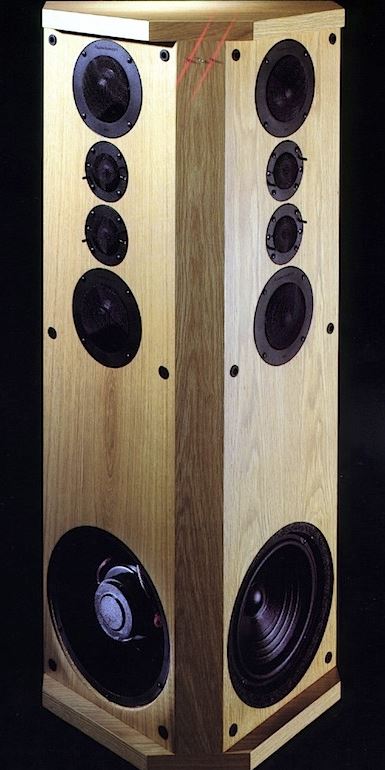
It's a fact that wall mounters have small bafflestep coils, so you have little scope for filtering the basic response. So it's good to use drivers that are well-behaved mechanically:
H1215-08 CA18RNX
Acoustic Research produced a tidy small wallmounter called the MST below. It's actually only about 10L volume. Also one of my low bafflestep (1mH coil) wallmounting 8" designs, maybe not quite what you are looking for, but a substantial bottom end. I quite fancy doing an MST variant on that.

It should be said, that unless you are extremely clever with crossover design and lobing issues, you should always have speakers at ear height. They do fall off pretty badly tonally off-axis.
The idea of mounting close to a wall causes a subjective and measurable increase in bass level. Here's a Roy Allison wallmounter:

It's a fact that wall mounters have small bafflestep coils, so you have little scope for filtering the basic response. So it's good to use drivers that are well-behaved mechanically:
H1215-08 CA18RNX
Acoustic Research produced a tidy small wallmounter called the MST below. It's actually only about 10L volume. Also one of my low bafflestep (1mH coil) wallmounting 8" designs, maybe not quite what you are looking for, but a substantial bottom end. I quite fancy doing an MST variant on that.
Attachments
That's a lovely house you and your wife have. Makes me miss being up in my home town. 🙂 (What are trees?)
Hello Giuseppe! Your message is clear enough, however you are asking questions that are still very general and broad. Speakers, especially to build your own, must be the DIY creative area of greatest freedom. Here are some questions to help us help you:
1. What types of music do you like to listen to? Obviously your amplifier limits how much power, but you can get very loud in a small room even with a small speaker and 35 watts.
2. How much money are you willing to spend? You do not need to spend huge amounts to get good sound. I am just an amateur, but I could buy (at USA prices, cheaper than Europe certainly -- even for European stuff !!! 😀 ) drivers for two speakers $100 or less. More $ gets you more quality but diminishing returns at some point.
3. What, if any, materials (wood?) and tools (work shop? Space Age CNC wood works when the boss is away? Or just a Swiss Army Knife?) Speakers are built using anything from foamcore board, glue and a sharp knife (look for xrk971's designs) to professional carpentry that rivals or exceeds the best commercial products.
4. DIYAudio is, in my opinion, the best site for (well...) audio DIY. Of course there are many other forums too.
5. You should get plenty of advice, but please tell us a few more details.
Thanks for answer.
1. I listen several type of music: rock, pop, rap, disco, opera... In any case my favourite music il rock (Guns N' Roses, Metalica...) and my favourite group is Queen
2. I would spend about 100 Euros, and definitely less than 150 €
3. I have no preferences about material. I supposed to use MDF, but I'm open to other suggestions
4. I first try to buy something like pioneer cs-3070. But I have several constraint about aspect. Speakers should be white or black, bright and without protection grid. Just to give you an idea (but I never buy it) please refer to LG FA162 speakers
regards
Giuseppe
Putting the dome tweeter in a waveguide like the JBL AC15 does can help "aim" the sound stage toward the listener from a 2.2m high shelf. BUT it also increases the box height, so only you can judge the fit. The JBL AC15 gets good reviews. For diy, there are modest cost waveguides which fit standard low cost dome tweeters.
Common wisdom:
-try to put the speaker at seated ear level ~36"-42".
-If the speaker stays up at 2.2m, try to fit the height a tweeter waveguide plus a 5" midbass into your shelf.
-If you need deep bass and cannot add a 60-80Hz shared woofer, an equalized 6" side woofer on these speakers can be successful, even when near walls. You could develop a plan which adds these side woofers when more money is available. The Barefoot Company's MicroMain 35 monitor uses advanced electronics to "sound big".
Common wisdom:
-try to put the speaker at seated ear level ~36"-42".
-If the speaker stays up at 2.2m, try to fit the height a tweeter waveguide plus a 5" midbass into your shelf.
-If you need deep bass and cannot add a 60-80Hz shared woofer, an equalized 6" side woofer on these speakers can be successful, even when near walls. You could develop a plan which adds these side woofers when more money is available. The Barefoot Company's MicroMain 35 monitor uses advanced electronics to "sound big".
Attachments
This could be a good idea about dimensions... but I think create some problem about sound direction.
If I put speakers at 2.2m from the floor I have to direct them to bottom, and using your suggestion the woofer will be directed to the top.
If I put speakers at 2.2m from the floor I have to direct them to bottom, and using your suggestion the woofer will be directed to the top.
Maybe a sub-sat type of system? The satellite speakers can be these:
Fountek FR88EX 3" build:
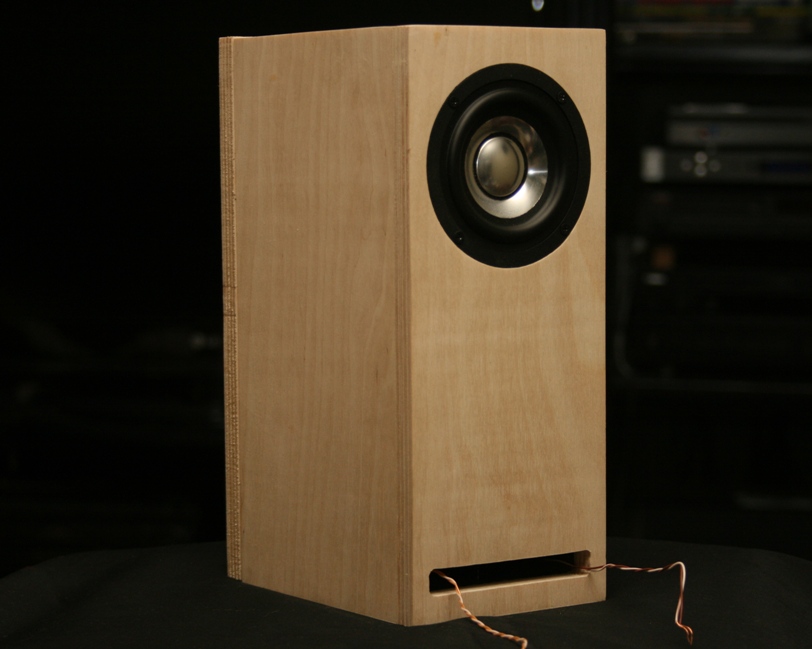
Then just build a good sub (many designs available).
Fountek FR88EX 3" build:

Then just build a good sub (many designs available).
LXMini or perhaps somthing like this trimmed down to fit on a bookshelf?

The Tang Band mini subs eat power. Even for fairly sane levels, I'd recommend 200w/ch. I had the 6.5" ones on a Behringer NU6000 (around 2kW/ch into 4ohm), and was lighting up the -6dB LED, meaning ~500w/ch peaks.
It was pretty loud by that point, and I didn't keep it at that volume for long - they're rated for 100w continuous IIRC.
Chris
I think it is better to start somewhere.
I'm trying to forgot dimension and position.
I selected following components:
Dayton Audio DC160-4 6-1/2" Classic Woofer Speaker
Dayton Audio DC28F-8 1-1/8" Silk Dome Tweeter
The woofer is bigger than you suggested me but it has a good range frequency.
What do you tink about them?
I'm trying to forgot dimension and position.
I selected following components:
Dayton Audio DC160-4 6-1/2" Classic Woofer Speaker
Dayton Audio DC28F-8 1-1/8" Silk Dome Tweeter
The woofer is bigger than you suggested me but it has a good range frequency.
What do you tink about them?
Giuseppe,
choosing what to do depends on what do you really want:
do you want to build a single set of speakers and done with that?
or do you want to start a hobby and learn how to create speakers?
If the first option is what you want, then find a reputable design and built it. All the engineering part is already done, and you can build a speaker without wasting time and money. In this case a design using the Dayton woofer could be this: https://sites.google.com/site/undefinition/classix-ii
If instead you want to start a hobby then you need several tools, HW and SW, and forget to build as a first attempt a good value-to-money speaker. I'm afraid, but a good speaker is not a couple of drivers put together with an off-the-shelf crossover. You need simulation SW, a calibrated mic, several spare parts (coils, caps and resistors), and time. A good place to start (for me) is here, where you can find free SW and a tutorial about how to design a speaker: software
If you want to follow that route, start with a simple 5.25" midwoofer +1" tweeter.
But I suspect you also need to understand something about drivers, driver parameters, bass alignment, diffraction. I haven't found a single reference that covers all those aspects.
Ralf
Placing a speaker on wall and not at ear level is generally a bad idea, and should be done only with care.
choosing what to do depends on what do you really want:
do you want to build a single set of speakers and done with that?
or do you want to start a hobby and learn how to create speakers?
If the first option is what you want, then find a reputable design and built it. All the engineering part is already done, and you can build a speaker without wasting time and money. In this case a design using the Dayton woofer could be this: https://sites.google.com/site/undefinition/classix-ii
If instead you want to start a hobby then you need several tools, HW and SW, and forget to build as a first attempt a good value-to-money speaker. I'm afraid, but a good speaker is not a couple of drivers put together with an off-the-shelf crossover. You need simulation SW, a calibrated mic, several spare parts (coils, caps and resistors), and time. A good place to start (for me) is here, where you can find free SW and a tutorial about how to design a speaker: software
If you want to follow that route, start with a simple 5.25" midwoofer +1" tweeter.
But I suspect you also need to understand something about drivers, driver parameters, bass alignment, diffraction. I haven't found a single reference that covers all those aspects.
Ralf
Placing a speaker on wall and not at ear level is generally a bad idea, and should be done only with care.
Hi Ralf
you focused the problem. Probably i have no time and no know how and no budget to start with second point. So I want to build a single set of speakers.
I like very much classix ii kit and in particular Freirik implementation.
Where I can buy the kit? I found meniscusaudio but it seems a little bit expensive.
Thanks
Giuseppe
you focused the problem. Probably i have no time and no know how and no budget to start with second point. So I want to build a single set of speakers.
I like very much classix ii kit and in particular Freirik implementation.
Where I can buy the kit? I found meniscusaudio but it seems a little bit expensive.
Thanks
Giuseppe
Classix-ii seems a good choice- The raw speakers will cost the approximate budget. Please note that the Dayton woofer is available in the 4 and 8 Ohm version -Guess what it's used ? 🙄 🙂
So it's the opposite of your choices: a 8Ω woofer and a 4 Ω tweeter
Add about 50 € for capacitors and coils ( and resistors ) for the crossover.
I see that everything is available at Audiokit...about 115 € for the speakers
So it's the opposite of your choices: a 8Ω woofer and a 4 Ω tweeter
Add about 50 € for capacitors and coils ( and resistors ) for the crossover.
I see that everything is available at Audiokit...about 115 € for the speakers
Last edited:
Some ideas, free or nearly so:
If you choose to design your own speakers, or just have fun, there are many programs for the PC (Mac too maybe?) that are free. I use Hornresp. Others are Akabak and [????]. These let you model and ask "what-if" questions without ever buying or building anything 🙂
Another suggestion, is to build prototype speakers. Xrk971 here is the master of building speakers out of foamcore (foam board). I do something similar, using plastic advertising signs (coroplast). Cardboard can also be used. This is perfect for smaller speakers (probably like yours you are creating). Even with my fast and sloppy builds, I get decent performance making small horn speakers. Are they perfect? No of course not. But I can build one in an hour (+ glue drying time.) The glue costs more than my raw materials 🙂
I've not done this, but some people like speakers built into the walls or ceiling. This would be unusual for you if you are in Europe since (1) you are not likely to own your home and (2) the wall is probably made of concrete or stone, not flimsy wood or gypsum board like here in the USA 🙄
There are so many options; my last suggestion (in this post!) is to read up on al the options you have, and you have a huge amount, even with your Euro 150 budget. Maybe spend it on drivers, mount them in a cardboard box, and worry about a wood cabinet later 😀
If you choose to design your own speakers, or just have fun, there are many programs for the PC (Mac too maybe?) that are free. I use Hornresp. Others are Akabak and [????]. These let you model and ask "what-if" questions without ever buying or building anything 🙂
Another suggestion, is to build prototype speakers. Xrk971 here is the master of building speakers out of foamcore (foam board). I do something similar, using plastic advertising signs (coroplast). Cardboard can also be used. This is perfect for smaller speakers (probably like yours you are creating). Even with my fast and sloppy builds, I get decent performance making small horn speakers. Are they perfect? No of course not. But I can build one in an hour (+ glue drying time.) The glue costs more than my raw materials 🙂
I've not done this, but some people like speakers built into the walls or ceiling. This would be unusual for you if you are in Europe since (1) you are not likely to own your home and (2) the wall is probably made of concrete or stone, not flimsy wood or gypsum board like here in the USA 🙄
There are so many options; my last suggestion (in this post!) is to read up on al the options you have, and you have a huge amount, even with your Euro 150 budget. Maybe spend it on drivers, mount them in a cardboard box, and worry about a wood cabinet later 😀
I would like to place the speakers at about 2.2m from floor with horizontal orientation (on a shelf) along the largest side.
I would like that the speakers are as small as possible.
Hi Giuseppe,
Your budget is workable for sure, but what you have described is a very suboptimal setup for speaker placement. There are very good reasons that most speakers are:
a) Oriented vertically. Multi-way speakers produce bad sounding "lobes" off-axis (this axis being the line of drivers), and we want these lobes directed away from the listener (toward the floor and ceiling).
Consider the difference between these two polar plots for the PSB Imagine Mini (a small 2-way speaker like you are proposing). Horizontal is first, then the vertical.
An externally hosted image should be here but it was not working when we last tested it.
An externally hosted image should be here but it was not working when we last tested it.
Note that although the horizontal plot extends all the way to 90 degrees each way, it is extremely smooth up to +-60 degrees and 15kHz (at high frequencies the polar response is unimportant). The vertical plot has some irregular troughs, and is asymmetrical.
In other words, if you orient the speaker horizontally, the sound on the left of the speaker will be noticeably different from the sound on the right. This means that not only your "sweet spot" will be considerably limited, but that reflections of the sound from side walls will differ in tonality from the direct sound, causing a poor blend (this is of crucial importance according to Dr. Floyd Toole).
From looking at the polar plots, the best solution for a 2-way speaker mounted above head level, is to place the woofer at the bottom (speaker is right side up), as the polar response is smoother on the "woofer side" of the speaker (though still not as good as the on-axis response). This placement would still allow for a smooth and symmetrical off-axis sound presentation in the horizontal plane, causing a wider sweet spot and early (wall) reflections which blend nicely with the original sound.
b) Not on a shelf. "Extremely early reflections" from surrounding objects (the back wall, the shelf itself, objects on the shelf) wreak havoc on the frequency response of the speaker. I will quote Floyd Toole again, though without graphs this time (the graphs are available in his book):
"As part of this, we need to locate the speakers. If the television is part of a wall unit or entertainment cabinet, the tendency is to put bookshelf speakers into cavities that are sometimes available. This is only a good idea if you stuff the space around the sides of the speakers with acoustical absorbent, such as fiberglass, acoustical foam, or even old clothing, towels or rags. Just cover the visible part of the stuffing with something presentable and preferably acoustically transparent, like fabric. A speaker in an untreated cavity cannot sound as it was intended. It is usually better for the sound if the speakers are free standing or, at least, sitting on top of an open shelf or cabinet."
c) Not against a wall. Here, it is important only that the crossover is designed to optimize the response for placement against a wall. Unless otherwise indicated, most speakers are optimized for a flat bass response when placed "out in the room". Make sure your speaker design is optimized for placement against a wall.
So my advice is not so much related to the design of the crossover or selection of drivers, but the placement of the speakers. I am 100% sure that following these advices will have a greater impact that selecting for instance, a different tweeter.
That said, I would recommend a waveguide tweeter (one which is set into a shallow horn), in any design which crosses a tweeter to a 6.5" woofer, in order to better match the directivity of the woofer. This is the only way to prevent "midrange suckout" at the crossover frequency. Midrange suckout happens because the woofer has started beaming as it approaches the crossover frequency, but then the tweeter takes over with full dispersion. So there is a "hole" in the off-axis response around the crossover - just the thing we are trying to avoid as per the discussion of polar response above.
Finally, here is a speaker design which can be built within your budget and addresses most of the concerns above, when placed in upper room corners: Bill Fitzmaurice TLAH
Good luck, enjoy the process, and enjoy your DIY system! 🙂
Last edited:
It's really an interesting idea, this wallmounter.
Bang and Olufsen did this sort of thing. Like the B&O P30, the wallmounting version of the S30. It came with mounting brackets on the back.
It even has a suitable down-firing tweeter for 2.2m high mounting.
Joe Rasmussen's "Elsinore" Peerless 830875 and 830874 would be suitable. Some adaptation required for single midbass, but just technique. Halve the coils and resistors, double the capacitors. FWIW, designed for a waveguide tweeter as dynomike likes, but that is optional IMO.
Elsinore Nomex Drivers
Being a wall mounter, with 6dB gain at the bottom, you don't need the bass, just the midbass. The Classix II might be a bit bassy IMO. It's a standmounter.
I have seen flush wallmounters with the entire wall covered in 2" rockwool except a waveguide cutout for the drivers, but that may be mission creep... certainly no Wife Approval Factor there!
Bang and Olufsen did this sort of thing. Like the B&O P30, the wallmounting version of the S30. It came with mounting brackets on the back.
It even has a suitable down-firing tweeter for 2.2m high mounting.
Joe Rasmussen's "Elsinore" Peerless 830875 and 830874 would be suitable. Some adaptation required for single midbass, but just technique. Halve the coils and resistors, double the capacitors. FWIW, designed for a waveguide tweeter as dynomike likes, but that is optional IMO.
Elsinore Nomex Drivers
Being a wall mounter, with 6dB gain at the bottom, you don't need the bass, just the midbass. The Classix II might be a bit bassy IMO. It's a standmounter.
I have seen flush wallmounters with the entire wall covered in 2" rockwool except a waveguide cutout for the drivers, but that may be mission creep... certainly no Wife Approval Factor there!
Attachments
Last edited:
- Status
- Not open for further replies.
- Home
- Loudspeakers
- Multi-Way
- Build very slim speakers
